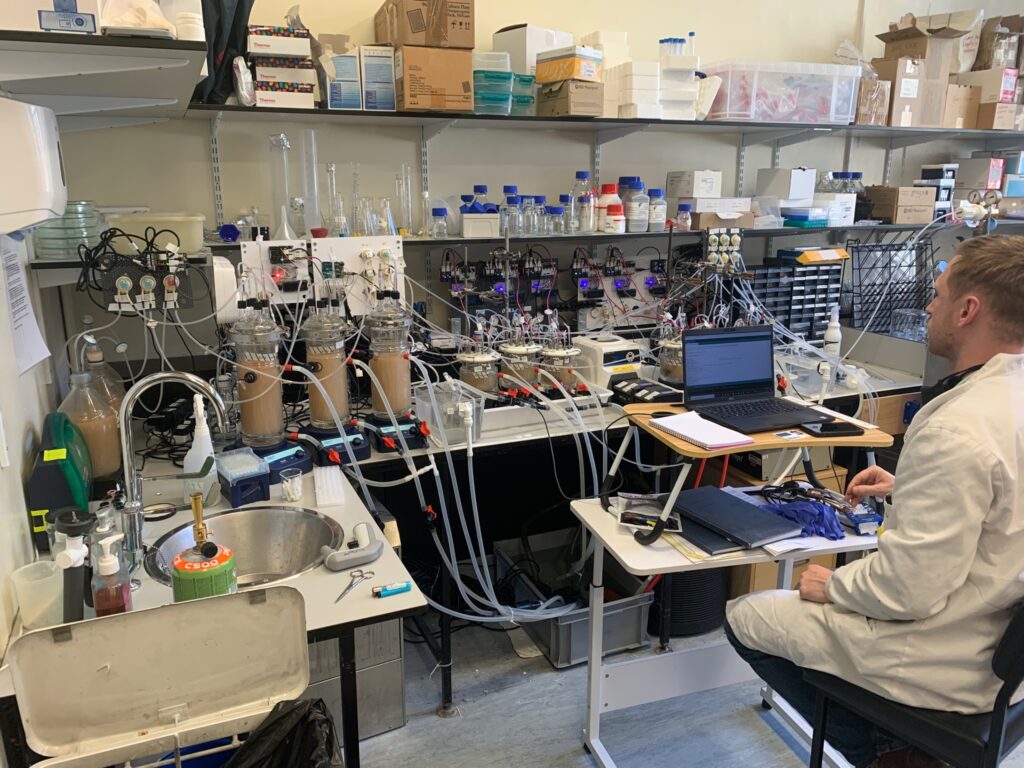Plastic-fed insects could be viable aquafeed, study finds

Insects fed on plastic could be a viable part of the diet for farmed fish, a Glasgow-based study has suggested.
SalmoSim, an in-vitro gut salmon gut simulator based at the University of Glasgow, has found that waxworms fed on plastic waste are as digestible for farmed salmon as other commercially available insect meals.
Waxworms are the larvae of the wax moth Galleria mellonella. Evolved to eat the detritus inside beehives, including beeswax, the caterpillar larvae can even digest polyethylene, which is inedible for most other organisms. They are able to do this with help from the bacteria in their gut. Waxworms are currently used as feed for pet reptiles, amphibians and birds.
Hopes have already been raised that waxworms could help tackle the global plastic pollution crisis. SalmoSim’s findings go a step further, suggesting that protein sources for farmed fish could be derived from insects which have been used to digest plastic waste, thus contributing to the wider circular economy.
Using insects to substitute for marine ingredients in aquafeed would reduce the pressure on wild fish, and polyethylene is a difficult plastic to recycle. If plastic-fed waxworms could be used to feed farmed fish, this would solve two environmental problems at the same time.
SalmoSim was developed to study the salmon’s gut microbiome. The company, a spin-out from the University of Glasgow, has now developed “SalmoSim Digest”, which predicts the digestibility of alternative ingredients alongside a model for the absorption of nutrients by the fish. Benchmarking of the SalmoSim-Digest model against tests on real salmon show that SalmoSim is 87% accurate.
The experiment tested the hypothesis that waxworms fed low-density polyethylene (LDPE) could be a more accessible source of protein for fish feeds.
As part of the testing process, waxworms were maintained with a diet of either LDPE plastic (cling film) or a traditional balanced diet while waxworm growth was monitored. Waxworms fed LDPE gained weight compared to unfed controls.
A whole waxworm meal powder was produced and subjected to the SalmoSim digestibility assay, with digestive phases mimicking the stomach, pyloric caecum, mid-gut and hind-gut of Atlantic farmed salmon. During enzymatic digestion, small nutrients were absorbed from the digesting feed and the amount of absorbed amino acids were determined by spectrophotometric assay.
In-vitro digestibility was calculated by comparison of crude protein concentrations before and after the digestibility assay in a manner mimicking live salmon feeding trials to determine a digestibility coefficient value for each bioreactor digesting the ingredients.
No significant difference in absorbed amino acids was found when comparing the control waxworms with those fed LDPE plastic, indicating their plastic diet did not impact on the waxworm’s concentrations of amino acids digestible by salmon. Interestingly, SalmoSim said, the overall digestibility of plastic-fed worms was slightly higher than those fed on normal feed, although in terms of energy and protein content they are less rich than, for example, mealworms or black soldier fly larvae.
Martin Llewellyn, Professor of Molecular Ecology at Glasgow University and Founding Director of SalmoSim said: “We are hugely encouraged by these data which indicate waxworms used to break down plastic could be a potential source of protein for farmed Atlantic salmon. As the pressure on wild fish stocks used for fish meal continues to grow, the need to find alternative, sustainable and low-cost feed stocks for farmed fish has never been greater.
“While the next step is to ensure that plastic-fed wax worms pose no toxicity to salmon, and can safely enter the human food chain, there is clearly exciting potential here and we look forward to continuing with our research into sustainable protein sources for farmed Atlantic salmon.”
He added that the SalmoSim approach is ideal for trying out novel feed ingredients before risking them on live fish: “Because it’s a simulator, you can afford to be bold.”
To make waxworm meal a safe feed ingredient, any traces of harmful elements such as microplastics and ethylene glycol – which is essentially antifreeze and a toxic substance for fish – would need to be removed. Llewellyn is confident this would not be difficult, however.
The study suggests that compared to other insect meals, and benchmarked against fish meal, waxworms performed very well and could be an important source of feed for salmon. Further testing is now required, the company said, to establish that salmon reared on a diet that includes plastic-fed waxworms is safe for human consumption.

Technical Director Joseph Humble in the SalmoSim lab

